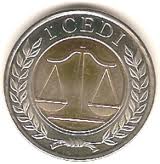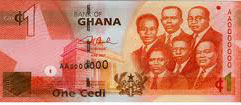|


The cedi (currency sign: ₵; currency code: GHS) is the unit of currency of Ghana. One cedi is divided into one hundred pesewas. The present cedi was introduced on July 3, 2007, and was equal to 10,000 old cedis when redenomination saw four zeros lopped off the value. It was the highest-valued currency unit issued by sovereign countries in Africa in 2007.
The word "cedi" is derived from the Akan word for cowry shell. Cowry shells were once used in Ghana as a form of currency.
A number of Ghanaian coins have also been issued in Sika denominations. These are probably best considered as "medallic" coinage, and may have no legal tender status. The word sika means "gold".
Currency sign
The Ghanaian cedi symbol ₵ resembles the letter C struck through with a vertical bar. The symbol was accepted for encoding in Unicode as U+20B5 in 2004. It should not be confused with the colón sign ₡, which has a code point U+20A1 in Unicode (or 8353 in decimal); or the cent sign ¢, which has a code point U+00A2 in Unicode (or 162 in decimal). However, because some fonts do not provide a cedi character, the cent sign is sometimes used as a replacement for the cedi.
History
First cedi, 1965–1967
The first cedi was introduced in 1965, replacing the pound at a rate of 2.4 cedi = 1 pound, or 1 pesewa = 1 penny. The first cedi was pegged to the British pound at a rate of 2.4 cedis = 1 pound.
Second cedi (GHC), 1967–2007
The first cedi was replaced in 1967 by a 'new cedi' which was worth 1.2 first cedis. This allowed a decimal conversion with the pound, namely 2 second cedis = 1 pound. The change also provided an opportunity to remove Kwame Nkrumah's image from coins and notes.
The second cedi was initially pegged to the British pound at a rate of 2 cedi = 1 pound. However, within months, the second cedi was devalued to a rate of 2.45 second cedi = 1 pound, less than the value of the first cedi. This rate was equivalent to 1 cedi = 0.98 US dollars and the rate to the dollar was maintained when the British pound was devalued in November 1967. Further pegs were set of $0.55 in 1971, $0.78 in 1972 and $0.8696 in 1973 before the currency was floated in 1978. High inflation ensued, and so the cedi was re-pegged at ₵2.80 = $1.00.
Inflation continued to eat away at the cedi's value on the black market. In the early eighties, the government started cracking down hard on the retail of products at prices other than the official established sale price (price controls). This had the effect of driving nearly all commerce underground, where black market prices for commodities were the norm, and nothing existed on store shelves. By 1983, the cedi was worth about 120 to one US dollar on the black market, a pack of cigarettes cost about ₵150 (if they could be found), but the bank rate continued at ₵2.80 = $1.00. Finally, with foreign currency completely drying up for all import transactions, the government was forced to begin a process of gradual devaluation, and a liberalization of its strict price controls. This process ended in 1990 with a free float of the cedi against foreign currencies. Inflation continued (see exchange rate chart) until by July 2007, the cedi was worth about 9500 to one US dollar, and a transition to the third cedi was initiated.
In 1979, a currency confiscation took place. New banknotes were issued which were exchanged for old at a rate of 10 old for 7 new. Coins and bank accounts were unaffected.
A second confiscation took place in 1982, when the ₵50 note (the highest denomination) was demonetized. Ghanaians, in theory, could exchange any number of ₵50 notes for coins or other banknotes without loss, but foreigners could not make any exchange. However, many Ghanaians who were hoarding large amounts of Cedis feared reprisal if they tried to convert all of it, and so simply burned a lot of their money. Many other Ghanaians received "promise payment notes" from the banks, but never received compensation. This confiscation was publicly justified as a means to create a disincentive for the flourishing black market. However, from a monetary perspective, currency confiscations have the effect of reducing the available cash in the economy, and thereby slowing the rate of inflation. After the ₵50 note confiscation, the ₵20 note was the highest cedi denomination, but had a street value of only about $0.35 (US).
After the ₵50 note confiscation, fears existed that the Government could also confiscate the ₵20 or even the ₵10 notes. This fear, along with inflation running at about 100% annually, started causing Ghanaian society to lose its faith in its own currency. Some transactions could only then be done in foreign currencies (although that was technically illegal), and other more routine transactions began to revert to a barter economy.
Third cedi (GHS), 2007–
On July 1, 2007, a third cedi was introduced, worth 10,000 second cedis. The external purchasing power of the old and new currencies are the same; the cedi was neither devalued nor re-valued, only redenominated. Because of this change, Ghana's currency became one of the highest-valued currency units from one of the least valued currency units.
A new ISO currency code GHS was also introduced on this date. In addition, the central bank named the third cedi the Ghana Cedi and assigned the symbol GH₵ to distinguish it from the second cedi, currently known as the cedi with the symbol ₵. The Ghana cedi will, from January 2008, be simply known as the cedi.
Coins
First cedi
First cedi coins were issued in denominations of 5, 10, 25 and 50 pesewas. Smaller denominations were not needed as the ½ and 1 penny continued to circulate as ½ and 1 pesewa. All coins bore the portrait of Kwame Nkrumah.
Second cedi
Cedi coins
In 1967, coins for the second cedi were introduced in denominations of ½, 1, 2½, 5, 10 and 20 pesewas. In 1979, coins for 50 pesewas and 1 cedi were introduced. These were replaced in 1984 by smaller types alongside a new 5 cedi coin. All these early issues have since fallen out of circulation due to inflation.
In 1991, 10, 20, 50 and 100 cedi coins were introduced, followed by 200 and 500 cedis in 1996. These six denominations are still in circulation. However, the 10 cedis (~0.1 US cents) and 20 cedis (~0.2 US cents) coins were not seen much due to their small value.
Third cedi
The new coins are 1 pesewa (100 old cedi), 5 pesewas (500), 10 pesewas (1000), 20 pesewas (2000), 50 pesewas (5000) and 1 cedi (10,000).
Banknotes
All Ghanaian banknotes are issued by the Bank of Ghana.
The text on this page has been made available under the Creative Commons Attribution-ShareAlike License and Creative Commons Licenses
|
